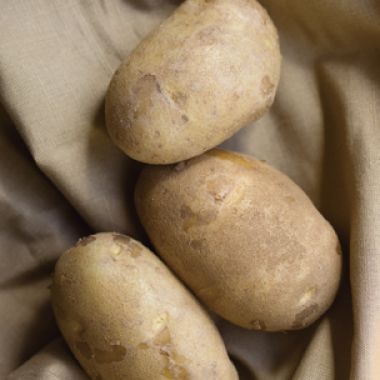All About Potatoes

The potato, a member of the nightshade family harvested during the summer, is today a symbol of normality and comfort. Easy to grow and to store, the starchy, faintly earthy-tasting potato is compatible with many other foods and endlessly adaptable to various cooking methods. It may be boiled and pureed into mashed potatoes, cut into long, thin sticks and deep-fried for French fries, or simmered in stews and soups.
Potatoes come in two main varieties: starchy, which become light and fluffy when cooked, or waxy, which are ideal for roasting or boiling for potato salads. New potatoes are small, immature waxy potatoes with a low starch content. They are typically available only in the spring and early summer.
Selecting
Most potato varieties are available year-round, although new potatoes may appear only in the spring and early summer and sporadically at other times. Choose firm specimens that are not blemished, wrinkled, tinged with green or cracked. The buds, commonly called eyes, of the potatoes should not have sprouted.
Storing
Store potatoes in a cool, dark place with good air circulation for up to 2 weeks. Do not refrigerate and do not store in the same bin with onions. These vegetables together produce gases that cause rapid spoilage. New potatoes have a much shorter shelf life than other potatoes. To make the most of their fresh, sweet flavor and texture, use them within 2 or 3 days of purchase.
Preparing
Potatoes are used both peeled and unpeeled. Whether or not you peel the potatoes, scrub them well with a stiff brush under cold running water to remove any dirt. If baking, prick the skins in a few places with a fork. If peeling, use a potato peeler, cutting out the eyes with a paring knife or the tip of the peeler, if necessary. If the flesh is tinged with green spots, be sure to pare away all traces of them, as they will taste bitter.
Quick Tips
- If you've oversalted a soup or stew, cut a boiling potato into slices and add it to the pot. Simmer for 5 to 10 minutes and then remove the potato slices, which will have absorbed some of the salt.
- If you must peel and cut potatoes in advance, put them in a bowl of cold water to keep them from discoloring, unless the recipe directs you not to do so. Some recipes, such as for latkes, rely on the surface starch of just-cut potatoes to bind the potato mixture during cooking. Other recipes, such as for French fries, will direct you to rinse potatoes in order to remove the starch that might otherwise cause the pieces to stick to one another or to the pan.
- For the fluffiest, lump-free mashed potatoes, use a ricer or food mill.
Adapted from Williams-Sonoma Kitchen Companion: The A to Z Guide to Everyday Cooking, Equipment and Ingredients (Time-Life Books, 2000)